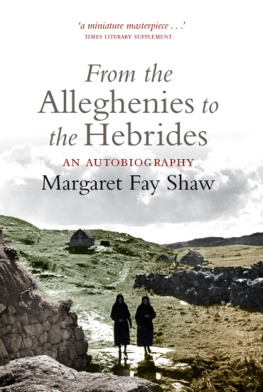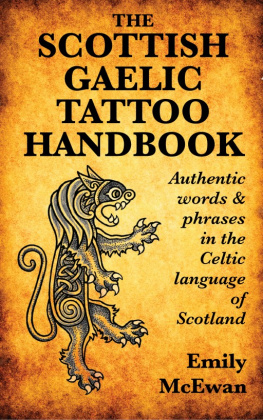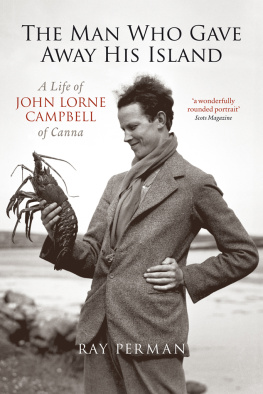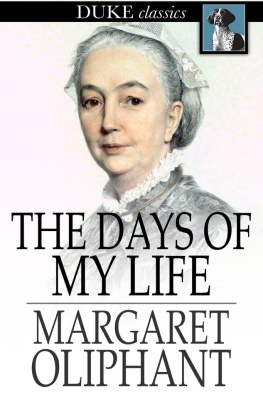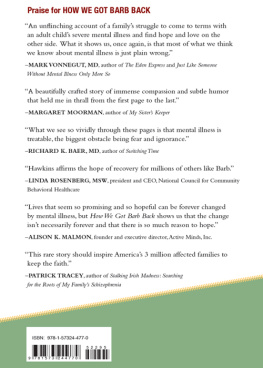Contents
Guide
FROM THE ALLEGHENIES TO THE HEBRIDES
An Autobiography
Margaret Fay Shaw

This edition first published in 2018 by
Birlinn Origin, an imprint of
Birlinn Limited
West Newington House
10 Newington Road
Edinburgh
EH9 1QS
www.birlinn.co.uk
Copyright the Estate of Margaret Fay Shaw
Introduction copyright Hugh Cheape 2008
First published in 1993 by
Canongate Books Ltd, Edinburgh
First published by Birlinn Ltd in 2001
All rights reserved.
No part of this publication may be reproduced,
stored or transmitted in any form without the
express written permission of the publisher.
ISBN13: 978 1 91247 607 7
eBook ISBN 978 0 85790 285 6
British Library Cataloguing-in-Publication Data
A catalogue record for this book is available from the British Library
Typeset by Geethik Technologies, India
Printed and bound by Clays Ltd, St Ives plc
Contents
Acknowledgements
Writing this book and putting it together has required endless help from Ann Evans Berthoff. I am also indebted to Robin Humes for typing the manuscript, and to Hugh Cheape for checking the proofs with such diligence. I am grateful to the Scottish Arts Council and to the many friends whose encouragement made this books publication possible. Finally I want to thank Kathleen Raine for giving me permission to use two of her poems in my book.
Foreword
Some years ago I was at a dinner party in New York. I left with another guest well after midnight to find a taxi. It was not a yellow cab but obviously one that belonged to the driver. It had no light inside. A very large man drove with his left hand while his right arm was extended along the seat. From Central Park West we crossed to Fifth Avenue and 60th Street where we left my companion at her club. Then we started to Park Avenue and to my destination at the far end on the edge of Harlem. He drove at a crawl and asked me where we two ladies came from as he liked our accents. I said that the lady came from London and I came from Pennsylvania but lived in Scotland. And where did he come from? A little town in Arkansas you never heard of but what took you to Scotland? We continued to travel at a snails pace.
I found myself telling him my life history and when I told him of the island of Canna, that it was a farm, he asked me questions that were a pleasure to answer. The kind of sheep, the quality of their wool, the cattle, what I meant by hill cattle and Highland cattle, the crops, the weather.
Lady, he said, you should write a book. Its the kind of book I like to read and make it two generations. And when we reached my door he thanked me for giving him my story and said, Lady, you write that book and remember it was a New York taxi driver that inspired you to do it.
Introduction
So much of Margaret Fay Shaws life was summed up in aphorisms and metaphors, either her own or others as she recounted them, when in later life she described herself for example as a bird blown off course. We might imagine that this stood for the highly unusual outcome of a young American settling in the Scottish Hebrides in the 1920s, but Margarets life can be perceived more broadly as a flight from constraints and conventionality. As her account unfolds, we sense a flight from social and family constraints away like a migrating bird to new experiences of place and people in regions then unimaginable to her compatriots of the Alleghenies. Though loyal to her adopted country, she remained robustly independent throughout her long life and deprecated in lively terms the tribal behaviour and complacency of cosmopolitan Scots. Evident in the structure of this autobiographical account, her life was measured out in a series of dramatic personal episodes themed by strength of character and indomitable will and spirit sustaining her in a course largely going against the flow. When facing up to the forces of constraint and convention, she would frequently say, reminding us of her love for the land of her birth and pride of ancestry: Im made of Pittsburgh steel!
Her independence or flight was never sentimental or escapist as her own achievements demonstrate. What might seem unremarkable interests in an educated twentieth-century individual, in music, in reading and writing, in photography, in the appreciation of the tangible and intangible, take on the quality of the extraordinary in Margarets life of changing and varied fortunes. In terms of the times, she engaged with people in a highly unconventional but uniquely personal way, disregarding entirely social mores, and became the distinguished collector and editor of Scottish Gaelic song and traditional material, as well as photographer and recorder of a Hebridean way of life.
Born at the old family home of Glenshaw, near Pittsburgh in Pennsylvania, on 9 November 1903, she was the fifth and youngest of the children of a civil engineer of Scottish descent, Henry Clay Shaw, and Fanny Maria Patchin of a New England family. In childhood she thrived on the personal and spontaneous but rebelled against the formalities of upbringing and education. In 1921 she was sent to school in Scotland for a year following the death of her parents. She heard the song collector and Celtic-Romantic doyenne, Marjory Kennedy Fraser, singing her Songs of the Hebrides at St Brides School, Helensburgh, and was inspired to learn about Hebridean music and song. She describes how these were impressive as art songs but that qualitatively different music as well as the Gaelic language lay behind them. These she pursued after a classical training studying piano in New York, London and Paris. Piquantly described travels led to Uist and a transcendental attraction that changed her life.
Margaret went to stay in South Uist in 1928 and the next six years were spent in the house of Peggy and Mary MacRae in Glendale, South Lochboisdale. The communities of Loch Boisdale lay at the centre of Margarets affections and supplied a deeply sincere and recurring refrain which fascinated friends and scholars over the years. The people of South Uist were her big family. Here she learnt Gaelic and took down songs, stories and traditional material from the MacRae sisters and from their neighbours in the Uist crofting townships. This work was done with great care and without the aid of any recording equipment. It required a thorough knowledge of the language and a musical skill and agility to transcribe a complex of modes and scales. In Gaelic song, the words and music are highly integrated and the phonetic structure of the language among the most complicated in the world. She describes how she had to forget the major and minor scales of the classically trained pianist and had to listen and learn. She based her editorial technique on a book of folksongs which she had bought in Dublin in 1927, following a chance-meeting with Mrs Costelloe of Tuam, a senator from County Mayo. The latter, as Eibhln Bean Mhic Choistealbha, had published the collection Amhrin Mhuighe Sela with the Talbot Press in 1923 and included full texts, provenance, sources and proper apparatus criticus.
During this time Margaret also made films and took photographs of life in the Islands and further afield and these have been used in journals, books and broadcasting over the years. The odyssey outlined in the chapters that follow is matched by a graphic storehouse illustrating trips to Galway and the Aran Islands, Barra, Mingulay and St Kilda, which she visited in May 1930 on the eve of evacuation. With the passage of time, the archive which Margaret Fay Shaw built up has emerged as a unique and precious view of the Hebrides; this was not the fancy of the passing tourist but the lifes work of one who had dedicated her career to the study of disappearing ways of life in the British Isles and of one who took the trouble to learn the language and to live within and understand the culture which she has subsequently written on with such cogency and conviction. For her photography and a lifetimes achievement, the Royal Scottish Geographical Society awarded Margaret Honorary Fellowship in November 2004.

